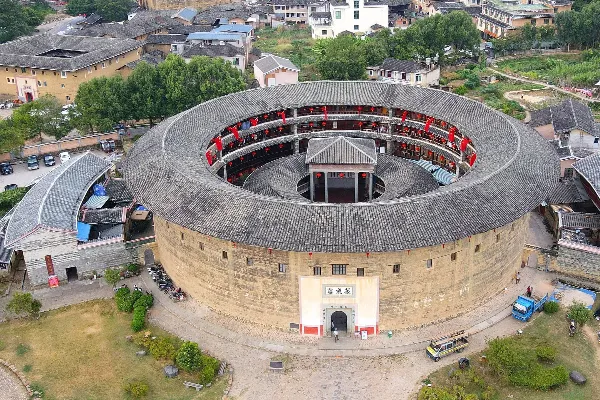
The Fujian Tulou (Yongding) Scenic Area is located in Yongding District, Longyan City, Fujian Province. As a national 5A-level tourist attraction and UNESCO World Heritage Site, Yongding boasts the highest concentration of tulou in Fujian, with over 23,000 existing earthen buildings, including more than 8,000 famous ones dating back to the Ming and Qing Dynasties. Covering approximately 220 square kilometers, the scenic area includes several tulou clusters such as Hongkeng, Gaobei, Chuxi, and Nanxi. The most representative Zhenchenglou is hailed as the "Prince of Tulou," while Chengqilou enjoys the title "King of Tulou."
History and Culture
Yongding tulou originated in the Tang Dynasty and matured during the Ming and Qing periods, created by Hakka ancestors as unique dwellings to defend against invaders and wild animals. Built along mountain contours using rammed earth, wood, and pebbles with "three-in-one earth" techniques, these structures feature windproof, earthquake-resistant qualities and maintain warmth in winter while staying cool in summer.
More than architectural marvels, the tulou are living fossils of Hakka culture. Circular tulou symbolize the ancient Chinese cosmology of "round heaven and square earth," while their internal structures reflect Hakka traditions of clan cohabitation. Each tulou functions as a miniature society with ancestral halls, schools, and wells, preserving self-sufficient lifestyles.
In 2008, Yongding tulou were inscribed as core components of "Fujian Tulou" on the UNESCO World Heritage List. These centuries-old buildings still house residents today, continuing Hakka living traditions and earning the reputation as "unique mythical mountain-dwelling architecture in the world."
Main Attractions
Zhenchenglou
Built in 1912, Zhenchenglou is Yongding's tulou masterpiece, acclaimed as the "Prince of Tulou." This circular building follows Bagua (Eight Trigrams) layout with two concentric rings - the outer four stories and the inner two stories - featuring numerous East-meets-West architectural details. Its unique structure embodies "one building, two systems," preserving tradition while incorporating Western elements.
Chengqilou
Constructed during the Chongzhen era of Ming Dynasty with a 73-meter diameter, Chengqilou is Yongding's largest existing circular tulou, honored as the "King of Tulou." Its four concentric rings decrease in height inward toward the ancestral hall at the center. At its peak, it housed over 80 families (600+ people), and still accommodates descendants of the Jiang clan today.
Hongkeng Tulou Cluster
Hongkeng Folk Culture Village contains one of Yongding's densest tulou concentrations, with 40+ large and small tulou from Ming-Qing periods. Notable buildings like Zhenchenglou, Kuijulou, and Fuyulou each showcase distinct characteristics, forming a picturesque tulou community that completely preserves traditional Hakka village life.
Chuxi Tulou Cluster
The Chuxi cluster comprises five circular and dozens of square tulou built along mountains and streams, including 600-year-old Jiqinglou. With relatively fewer tourists, it retains more primitive and rustic tulou features, offering authentic Hakka living experiences.
Cuisine
Yongding Beef Balls
Local specialty made by hand-pounding yellow beef into paste mixed with tapioca flour. The springy, chewy balls are served in flavorful broth, typically garnished with cilantro and pepper.
Hakka Stuffed Tofu
Classic Hakka dish where tofu is hollowed, stuffed with minced meat, pan-fried golden, then braised. The crispy exterior and tender interior perfectly blend bean and meat flavors, essential for Hakka hospitality.
Taro Dumplings
Yongding specialty with wrappers made from taro and tapioca flour, filled with ingredients like mushrooms and minced pork before steaming. The soft, sticky skin and savory filling carry rich taro aroma.
Tulou Rice Wine
Traditional Hakka brew using premium glutinous rice fermented and distilled through ancient methods. The clear wine has mellow taste with lingering aftertaste, a must-have for Hakka hospitality.
Ticket Information
Yongding Tulou implements zoned ticketing: Hongkeng cluster ¥90/person; Gaobei cluster ¥50/person; Chuxi cluster ¥65/person. A combo ticket for Hongkeng and Gaobei is ¥120/person. Seniors over 60 and students enjoy 50% discount, while children under 1.2m enter free. Opening hours are 8:00-18:00.
Suggested Itinerary
Recommended one-day tour: Visit Hongkeng cluster (Zhenchenglou → Kuijulou → Fuyulou → Rushenglou) in the morning, enjoy lunch at a tulou farmhouse; explore Gaobei cluster (Chengqilou, Wuyunlou, etc.) in the afternoon. With more time, stay overnight in Chuxi for more authentic tulou living experience.
Transportation
- Self-drive: From Xiamen via G76 Expressway to Yongding exit, then about 1.5 hours on county roads to scenic area
- Public transport: Direct tourist buses available from Xiamen Hubin South Bus Station to Yongding Tulou
- Within scenic area: Shuttle buses connect major sites; walking or local motorcycle rentals are alternatives
Must-See Attractions
- Zhenchenglou - "Prince of Tulou" with East-West fusion architecture
- Chengqilou - "King of Tulou" with grand scale
- Hongkeng Cluster - Comprehensive display of various tulou types
- Chuxi Cluster - Primitive and rustic tulou features
Travel Tips
- Spring and autumn are ideal seasons with pleasant weather
- Wear comfortable, non-slip shoes for stone-paved tulou interiors
- Bring sun protection and rain gear - mountain weather changes rapidly
- Allocate sufficient time - at least 30-60 minutes per tulou
- Experience Hakka life by staying in tulou homestays
Important Notes
- Most tulou are residential - maintain quietness during visits
- Avoid touching walls and artifacts to preserve heritage
- Drive cautiously on winding mountain roads if self-driving
- Purchase local products from authorized stores only
- Download offline maps as some areas have weak signals